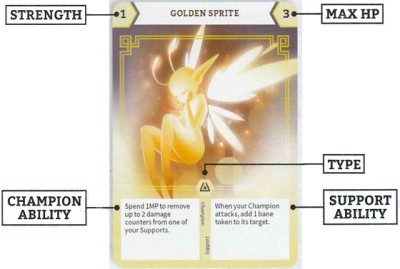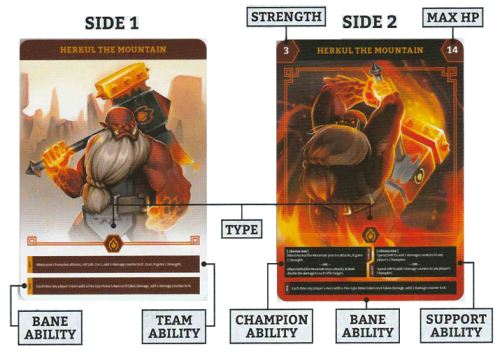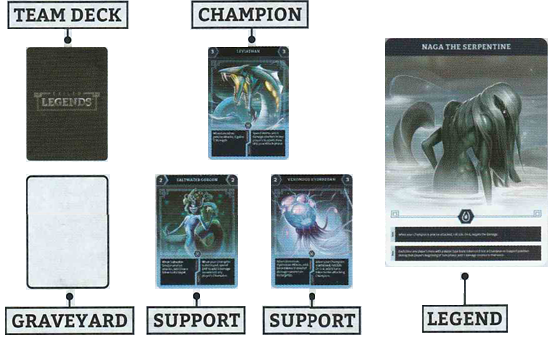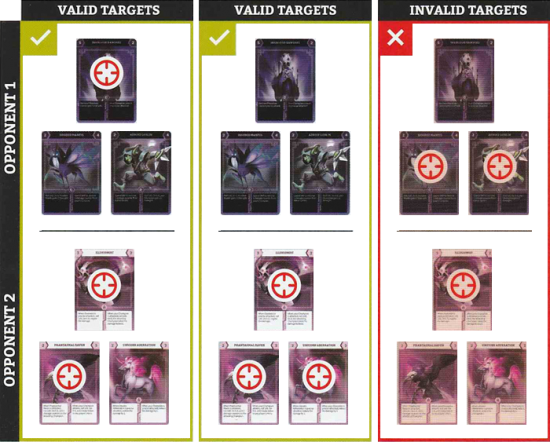Exiled Legends - Rules of Play
General Information
What Is In The Box
- Hero Cards (50)
- Hero cards used to build your Team deck, and each Hero has a type. Types include Fire, Water, Light, Dark and Unknown. All Hero cards have a black back.
- Legend Cards (5)
- Legend cards lead each team and have powerful abilities that affect the flow of the game. All Legend cards are oversized and double-sided.
- Sphere Cards (15)
- Sphere cards change the Banesphere's terrain each round. Each Sphere card has a type and grants a benefit to Hero cards of that type. All Sphere cards have a white background.
- Bane Tokens (25)
- Bane tokens, which correspond to each Legend's Bane ability, are placed on Hero cards during the game to keep track of debuff effects. The color of each bane token corresponds to a specific Legend card.
- Myth Point Tokens (15)
- Myth Point tokens keep track of your Myth Points (MP), which are spent to use certain actions and abilities.
- Damage Counters (40)
- Damage counters to keep track of damage added to your Heroes.
- Six-Sided Dice (1d6)
How To Read Hero And Legend Cards
Below is a diagram that explains how to read a Hero card.
- Strength
- A Hero's Strength is the maximum amount of damage that Hero can deal when attacking (unless otherwise stated by an ability).
- Max HP
- A Hero's Max HP is the minimum number of damage counters that must be added to destroy it.
- Champion Ability
- A Hero's Champion ability can only be used when that Hero is in the Champion position.
- Support Ability
- A Hero's Support ability can only be used when that Hero is in a Support position.
Below is a diagram that explains how to read a Hero card.
In addition to the terms named in the Hero Card diagram, Legends have two additional abilities:
- Bane Ability
- A Legend's Bane ability determines the effect of that team's total bane tokens.
- Team Ability
- A Legend's Team ability gives that team an advantage when certain triggers occur.
Setup
How To Build The Decks
Each player must choose to play as a Legend card by taking that Legend Card. Once you have chosen a Legend, you must then build a Team deck using Heroes of the same type as that Legend. Each player will then select Sphere cards that will be combined to form a Sphere deck.
- The Team Deck
- There are 10 Hero cards of each type, but a Team deck can only include six cards. Read each Hero card, then select six to make up your Team's deck. Shuffle those six cards and place them in front of you, then place the remaining four cards back in the game box.
- The Sphere Deck
- Each player selects three Sphere cards to add to the Sphere deck. Shuffle the Sphere deck and place it in the middle of the table.
How To Set Up Your Play Area
Each player has a play area that includes a Team deck, a Graveyard, your Legend card, and three positions for Heroes (one Champion position and two Support positions).
Start by placing your shuffled Team deck at the top left of your play area and your Legend card at the far right of your play area. Your legend should start the game with its Team ability facing up (side 1). While your Legend is in this position, it cannot be attacked of affected by abilities. Later in the game, you will flip over your Legend card and use it as your final Hero (see: What to do when a Hero is Destroyed).
Look at the top three cards of your Team deck and select one to place face down in your Champion position. Place the other two face down in your Support positions. Once every player has made their selections, flip your Heroes face up.
How To Distribute The Remaining Components
Once each player has set up their play area, place all the damage counters in the middle of the table. Give each player two Myth tokens as well as all bane tokens that correspond to the Legend they chose.
Gameplay
How To Play The Game
To determine turn order, each player must roll the dice. The player with the highest roll goes first, with turns proceeding clockwise from that player.
The Round To begin the first round, the first player flips over the top card of the Sphere deck and takes their turn. The effect of that Sphere card is active until the round is over. Once every player has taken their turn, a new round begins, and the first player flips a new Sphere card face up.
If there are no cards left in the Sphere deck when the round begins, shuffle together all of the face up Sphere cards and place them face down to create a new Sphere deck.
The Turn Each turn is split into four phases:
- Beginning of Turn phase
- Action phase
- Attack phase
- End of Turn phase
Beginning of Turn Phase During your Beginning of Turn phase, refresh your Myth Points (MP) back to two is you spent any MP since the start of your last turn. If any abilities or effects caused by bane tokens trigger at the start of your turn, they occur during this phase.
Action Phase During your Action phase, you may choose to do any of the following:
- Spend 1MP to add a bane token to any Hero card;
- Spend 1MP to remove a bane token from any Hero card;
- Spend 1MP to remove a damage counter from one of your Supports;
- Spend 1MP to switch your Champion with one of your Supports;
- Spend 1MP to return a Support without damage counters or bane tokens to the bottom of your Team deck and flip the top card of your Team deck face up to replace it.
In addition to these actions, you may use any functional Champion or Support abilities. These are abilities that start with an action and do not require a trigger (see: Notes on Abilities).
None of these actions or abilities may be used more then once per turn. If you choose to use more then one action or ability, you man perform them in any order. If you proceed to your Attack phase without using an action or ability, you may not perform it during a later turn phase.
Attack Phase During your Attack phase, you may choose to do one of the following types of attacks:
- Precise Attack: Choose any other player's Champion as your target. Add damage counters equal to your Champion's Strength to that card. You may not precise attack a Support unless otherwise stated by an ability.
- Mass Attack: Chose a number of targets equal to your Champion's Strength. Add a damage counter to each of those targets. If your Champion's Strength is greater than the number of available target, add a damage counter to each available target. You may choose any player's Supports as targets of a mass attack, but only if you first choose that player's Champion as part of the same mass attack.
Below is a diagram that shows possible targets for a mass attack
Chosen Target = ![]()
Note: In the third example, Opponent 1's Supports are invalid targets because a mass attack cannot target any player's Supports without also targeting that player's Champion.
You must follow a specific order of resolution during your Attack phase.
- Declare your type of attack (precise attack or mass attack) and choose the target(s) of your attack. Calculate damage for each Hero targeted by the attack and place the corresponding number of damage counters next to that Hero. Note: These damage counters will not be added to the targeted Heroes until step three.
- Your attack may trigger the ability of another player's Hero. Allow each player with a targeted Hero to declare whether or not they will use a triggered ability. If a player uses a triggered ability, that player must choose targets (if applicable), and the effect of that ability resolves immediately. If that ability reduces or negates damage from an attack that targeted a Hero, remove the corresponding number of damage counters from next to that Hero.
- Once all triggered abilities have been resolved, add all damage counters from next to each Hero to those Heroes. Damage has now been dealt; however, even if a Hero would be destroyed by damage, do not place it in the Graveyard yet, as it may still have an ability that can be triggered.
- Adding damage counters or destroying a Hero may trigger additional abilities. Allow each player to declare whether or not they will use a triggered ability. If a player uses a triggered ability, that player must choose targets (is applicable), and the effect of that ability resolves immediately.
- Now that all possible abilities have been resolves, place any Hero card with damage counters equal to or greater than its Max HP in the Graveyard.
End of Turn Phase Declare the end of your turn and allow play to progress to the next player in turn order.
What To Do When A Hero Is Destroyed
If your Champion is destroyed, you must immediately place one of your Supports in the Champion position, then flip over the top card of your Team deck and place that card in the empty Support position.
If one of your Supports is destroyed, you must immediately flip over the top card of your Team deck and place that card in the empty Support position.
If your Champion AND both of your Supports are destroyed during a single Attack phase, you must immediately flip over the top three cards of your Team deck. Choose one of those cards to place in the Champion position and place the other two cards in the Support positions.
If you have no cards left in your Team deck and one of your Heroes is destroyed, you must use your Legend as your final Hero. Flip over your Legend card to reveal the side that shows its Champion and support abilities (Side 2). The effect of your Legend's Team ability is now inactive. Your Legend is now considered to be a Hero and can be chosen as the target of abilities that affect Heroes.
How To Win The Game
If your Legend is destroyed, your are out of the game. Note: Your Legend cannot be attacked or destroyed until it is flipped over and becomes your final Hero.
The last player remaining in the game is the winner!
Additional Notes
Notes On Abilities
There are four types of abilities: triggered, functional, continuous, and bane.
Triggered Abilities always start with the word "When" and define a specific trigger that allows the ability to be used. The effects of these abilities are optional. If you fail to declare that you are using one of these abilities when its trigger occurs, you lose the option to use it until that trigger occurs again.
Below are some examples of triggered abilities:
- When your Champion is precise attacked, roll 1d6. On 5-6, negate the damage.
- When your Champion is destroyed, add 1 damage to each of any player's Supports.
- When your Champion attacks, add 1 bane token to its target.
Functional Abilities always start with an action. The effects of these abilities are optional and can be used only during your Action phase.
Below are some examples of functional abilities:
- Spend 1MP to rearrange the top 3 cards of the Sphere deck.
- Roll 1d6. On 4-6, your Champion games 1 Strength
- Switch any player's Champion with one of that player's Supports.
Continuous Abilities always start with the name of the Hero. The effects of these abilites are not optional.
Below are some examples of continuous abilities:
- Chained Hellion can precise attack Supports.
- Inkblood Banshee cannot precise attack.
- Shapeshifter's Strength is equal to the strength of any player's Champion.
Bane Abilities are defined on each Legend card, and these abilities are used by adding bane token to a Hero. If one of your Heroes has a bane token on it, the effect of that bane token's ability is active until the token is removed or that Hero is destroyed.
When reading each card's abilities, there are a few important things to note:
- Any player refers to any single player, including you.
- Any other player refers to any single player, excluding you.
- Every player refers to every player, including you.
- Every other player refers to every player, excluding you.
Some abilities allow your Champion to do such things as "gain" Strength or "reverse" their Strength and Max HP stats. When used, these abilities last only until the end of your turn.
Legend cards each have two Champion abilities and two Support abilities. You may only use one of those abilities per turn.
Notes On Bane Tokens
There is no cap on the number of bane tokens that can be added to a single card; however, if there is more then one bane token of the same kind on a single card, their effects do not stack.
Example: There are two Fire-type bane tokens on the same card, and the ability for a Fire-type bane token reads "Each time any player's Hero with a Fire-type bane token on it takes damage, add 1 damage counter to it." Because the two bane tokens do not stack, that card would receive only one additional damage counter upon taking damage, not two.
Optional Drafting Rules
Looking for a challenge? Try playing with these optional rules for building your deck that allow you to play with Heroes of multiple types at once!
After each player has chosen their Legend card, shuffle together all of the Hero cards in the game box and deal six cards to each player. Place the remaining Hero cards back in the game box.
Look at the cards in your hand and choose one. Place it face down in front of you, then pass the remaining five cards in your hand to the player on your left. Continue this process of choosing one and passing it to your left until you have six cards face down in front of you. At this point, your Team deck is complete.
Next, place all Sphere cards face up in the middle of the table. Each player must roll the dice, and the player with the highest roll chooses the first Sphere card. Continue clockwise until each player has chosen three Sphere cards. Shuffle all the chosen Sphere cards together to form the Sphere deck, then proceed with the game.









